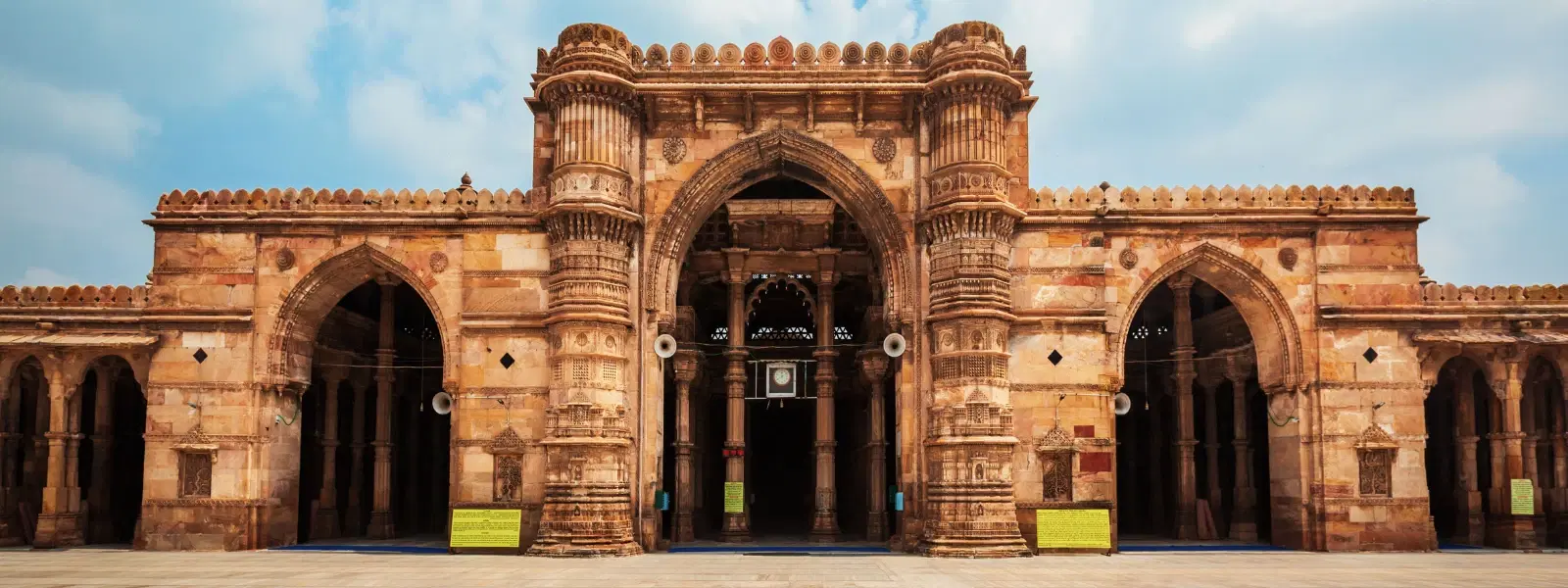
Hotels
•03 min read

The Siddi Sayyed Mosque in Ahmedabad is a mesmerizing masterpiece where history meets art. Known for its intricate jali work, the mosque is not just a place of worship but also a treasure trove of exquisite craftsmanship. In this post, you will discover answers to frequently asked questions about the mosque’s jali work, learn about its rich history, and appreciate its enduring cultural impact on Ahmedabad’s architectural heritage.
Constructed in 1572 by Sidi Saiyyed, a nobleman of the Gujarat Sultanate, the mosque stands as one of the last great architectural achievements before the Mughal era. Its creation marked the zenith of Islamic art in the region and demonstrated the visionary aesthetics of its time.
Over the centuries, the mosque has woven itself into the cultural fabric of Ahmedabad. Its timeline is as rich as it is vibrant, symbolizing an era when art and architecture were deeply interlinked with the socio-political landscape of Gujarat. The mosque’s enduring legacy reflects the might and sophistication of the Gujarat Sultanate, making it a cornerstone of local heritage.
The defining feature of the Siddi Sayyed Mosque is its intricate stone latticework, or jali. Crafted with precision, each window displays a fine pattern that combines both functionality and beauty. The most celebrated design, the "Tree of Life" motif, symbolizes growth, interconnectedness, and the eternal cycle of life's rebirth—a design that has captivated art enthusiasts for generations.
While the art of jali carving is a hallmark of many historic mosques in Gujarat and across India, the craftsmanship at the Siddi Sayyed Mosque stands out. The patterns not only serve as an essential element of light and ventilation but also echo the grand narratives of Islamic art and architecture. These designs are a fusion of geometry, nature, and spirituality, resonating with the broader tradition of Islamic artistry in India.

Artisans employed sophisticated techniques to create the delicate jali designs, chiseling stone with artistic precision. The skill, patience, and attention to detail required for such work have inspired modern architectural expressions. This passion for perfecting the craft continues to inspire contemporary architects and craftspeople.
The mosque's architecture is a graceful blend of Indo-Islamic design elements. Its elegant arches, domes, and the renowned jali work demonstrate the high level of craftsmanship prevalent in the Gujarat Sultanate era. Every corner of the mosque tells a story of artistic brilliance interwoven with centuries-old traditions.
Within the bustling city of Ahmedabad, the Siddi Sayyed Mosque is a standout heritage site. It not only attracts history buffs and scholars of Islamic art but also invites curious travelers who admire architectural marvels. The mosque finds its place among the most celebrated monuments in the city, serving as a bridge between the past and the present.
Insight Corner: The Tree of Life motif in the Siddi Sayyed Mosque’s jali work is not just a design—it symbolizes interconnectedness and the eternal cycle of life, making it a profound piece of art and philosophy.
The artistic expression found in the jali work of the Siddi Sayyed Mosque contributes significantly to the narrative of Islamic art in Ahmedabad. The detailed carvings influence local artisans and are reflective of traditional methods that have been passed down through generations. These influences can be seen in various art forms and architectural designs throughout the region.
The mosque is a must-visit for anyone exploring Ahmedabad’s heritage. As part of numerous cultural tours, it continues to attract tourists, historians, and art enthusiasts alike. Its role in preserving Gujarat’s history and inspiring future generations solidifies its status as not just a monument, but a living, breathing piece of art that represents the city's rich cultural legacy.

The Siddi Sayyed Jali is located in the Siddi Sayyed Mosque in Ahmedabad, Gujarat, India.
The jali was crafted as part of the mosque built by Sidi Saiyyed, a nobleman under the Gujarat Sultanate, in 1572.
The Tree of Life motif is the most famous design in the mosque’s jali work, symbolizing interconnectedness, growth, and the eternal cycle of life.
The intricate jali designs, especially the Tree of Life, have inspired modern architectural elements and continue to influence contemporary designs.
Its intricate stone latticework, historical significance, and unique Indo-Islamic architectural style make it a standout example of craftsmanship and heritage.
The Siddi Sayyed Mosque is a beacon of artistic brilliance and historical significance in Ahmedabad. Its rich history, intricate jali work, and enduring cultural impact not only celebrate the legacy of the Gujarat Sultanate but also continue to inspire modern architecture and arts. Whether you are a history enthusiast, an art lover, or a curious traveler, this mosque offers a glimpse into a glorious past that still lives on in every carved detail.